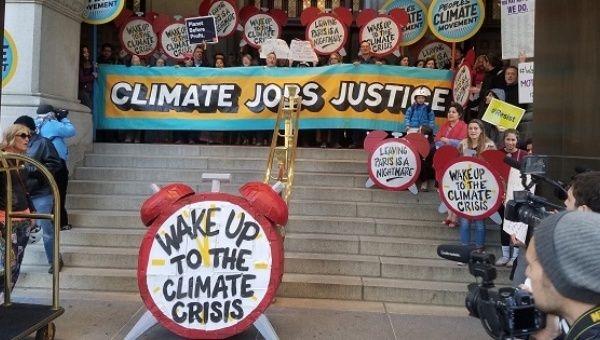US Exits Paris Agreement

US President Donald Trump made the shocking, but not unexpected, announcement last week that the US is pulling out of the Paris Agreement (PA) on climate change. 195 countries had endorsed PA last December and 147 nations have since ratified it.
The history of US betrayals of international climate agreements has thus repeated itself, the first time as tragedy, when President George W. Bush walked out of the Kyoto Protocol in 2001 soon after being elected, and now as farce.
In between, the international community continued to welcome the US to international climate negotiations in the annual Conference of Parties (COP) in the fond hope of bringing the US, till recently the world’s largest emitter of greenhouse gases, back into the fold. The US responded to this good faith by cynically manipulating the process, and maneuvering the international consensus towards a series of dilutions cumulatively serving to undermine the very architecture of the global emissions control regime.
Over the past decade or so, when terms governing the second commitment period of the Kyoto Protocol from 2013 onwards were being negotiated, it became increasingly clear that the US, first under Republican President Bush and then under Democrat President Obama, was essentially pushing for a completely new successor agreement, breaking away from the major principles hitherto anchoring the international agreement. Governments all over the world, from the developed EU to the developing and highly endangered island nations, bent over backwards to accommodate the US positions.
Many on the Left and in the radical climate movements questioned whether it was worth all these concessions to bring the US on board, especially since there were huge, dark domestic clouds, especially in the legislative branch on both sides of the aisle, hovering over any emissions reduction commitments the US administration might make. That question has now been answered. Copenhagen 2009 led inexorably to Paris 2016, a highly unsatisfactory agreement built on a wishful 2 degrees C goal, slippery voluntary emission reduction pledges, an unethical and unscientific disregard of historical emissions by the US and other developed countries which constitute the major driver of climate change, and vague wording about technology and finance transfers from developed to developing nations. And now the US has withdrawn even from this, leaving the world to carry the baggage which the US itself did the most to create.
Donald Trump has delivered a stinging slap on the face to all those governments and other advocates who had mistakenly placed so much faith in the USA. Worse, the Trump administration has told the whole world, especially developing countries and vulnerable nations, that it could not care less about the enormous social and economic, in some cases even existential, costs they will incur as a direct result of this American action.
Trump’s “alternative facts” The farcical nature of Donald Trump’s decision was rubbed in by the reasons he cited for it in the official White House Statement. Trump said PA was “an agreement that disadvantages the United States to the exclusive benefit of other countries.” This when the US had itself been its chief architect! No doubt Trump ascribed this to “Washington,” read the Obama administration and the US establishment as a whole. But Trump has his own unique vision, a parallel universe of “alternative facts.”
In PA, the US voluntarily pledged --- nobody imposed this on them --- to reduce its emissions by a meager 26-28 percent from 2005 levels by 2025. Most other developed countries followed the Kyoto Protocol practice of pegging 1990 as the base year. From 1990 to 2005, US emissions had risen 17 percent, bringing its Paris emissions reduction commitment to a miserly 9-11 percent from 1990 levels. In comparison, the EU pledge was for “at least 40 percent” reduction in emissions from 1990 levels by 2030. This is a huge benefit to the US, granting it a huge time advantage to shift to renewable energy and other emissions reducing technologies compared to its developing country peers, despite the US being the largest emitter, and the largest and technologically most advanced economy.
Yet, Trump also attacked the “draconian financial… burden the agreement imposes” on the US, especially the Green Climate Fund (GCF) “which is costing the United States a vast fortune.” Let us look at the real facts. Decisions at COP21 in Paris had projected that developed countries would together need to contribute a “floor of $100 billion a year” to assist developing countries meet climate challenges. But this has remained a fictional figure. The GCF has so far mobilized total pledges of around $10.3 billion, of which the US has pledged $3 billion but has so far actually contributed only $1 billion. Trump probably thought this was a disproportionately high figure for the US. But Japan has pledged half what the US has, even though its economy is a third of the size. The difference between the US and other developed countries is even more stark on per capita basis. Analysis by the GCF shows that the US contribution is $9.41 per capita, compared to $11.8 by Japan, $18.77 by the UK, and $59.31 by Sweden. Certainly not a “vast fortune” being spent by the US as Trump claimed.
Trump’s statement went on to cite various highly dubious figures for economic costs and job losses in the US due to its emissions reduction obligations. All figures cited were from a study by the National Economic Research Associates (NERA), a well-known right-wing economic consultancy organization that has in the past published notorious “studies” for the US coal industry front, the American Coalition for Clean Coal Electricity, and which also published reports against the US Clean Air Act and the US Mercury and Air Standards Rules, which were used as campaign tools by Republican legislators, climate deniers and fossil fuel lobbies. All these reports project humongous costs and alarmist job loss figures with little or no basis. NERA was founded by Irwin Stelzer, right-hand man to Rupert Murdoch of Fox News, with the advice of Alfred E. Kahn, often called the “father of deregulation.” In typical Trump style, his statement picks on a single, unreliable, right-wing source which suits the argument he wants to make.
If further evidence were needed that Trump lives in some cloud-cuckoo land, his statement claims that the Paris Agreement is so ineffectual that “it would only produce a two-tenths of one degree Celsius (0.2 degrees C) reduction in global temperature by the year 2100. Tiny, tiny amount.” Flagrantly false! The science is clear in IPCC’s projections in its continuously updated 4-yearly Assessment Reports, which shows temperature rise climbing beyond 5 degrees C by the end of the century while PA seeks to limit this to 2 degree C!
India (and China) The statement also contained sweeping broadsides against China, which at least is the world’s largest emitter, the world’s second largest economy and one with which the US has an extremely large trade deficit. He claimed that China will continue to increase its emissions and can “do whatever they want” for 13 years. In reality, while China as a developing country projected its emissions growth will slow down and peak around 2030, signs are that its emissions are close to peaking already, according to the independent Climate Tracker. But Trump’s most ill-considered, unfounded and unkind cuts were aimed at India. Trump has his facts all wrong about India.
He claimed that “India makes its participation contingent on receiving billions and billions and billions of dollars in foreign aid from developed countries.” Absolute nonsense! One may fault India’s NDC for not explicitly demarcating which mitigation or adaptation actions it will seek or utilize financial assistance from developed countries for, India has not stipulated any conditionality for foreign finances as regards any mitigation commitments. On the contrary, the major elements of India’s mitigation actions in its NDCs are well underway based solely on domestic financing.
Trump also claimed that “India will be allowed to double its coal production by 2020. Think of it… We’re supposed to get rid of ours.” Both parts of this statement are incorrect.
Before explaining this, it is necessary to make something clear. As envisaged in the UN Framework Convention on Climate Change, and as reflected in the Kyoto Protocol as well as PA, developed countries are expected to reduce their emissions below a given baseline (1990 in most cases, 2005 in others), while developing countries are allowed the leeway to slow down or taper-off their emissions growth which would be necessary to tackle poverty and development deficits. This is because climate change has been precipitated by the historical i.e. past emissions, over 77 percent of which have been put into the atmosphere by he developed countries. This is no great injustice to the US or other developed countries, but follows the ethical-legal principle of “polluter pays,” embodied in the UNFCCC principle of “common but differentiated responsibilities.”
So as not to cite Indian sources alone, Climate Tracker notes that, along with China’s slowing down of coal-fired electricity generation, “the ongoing growth of renewable energy and slowdown of coal in India is the most important development underway globally today.” It adds that India’s “Draft Electricity Plan projects that, despite the increasing electricity demand, no new coal capacity, apart from the capacity already under construction, would be needed after 2022.” India’s NDC further commits to have 40 percent of its electricity generating capacity projects coming from non-fossil fuel sources. India is clearly significantly ramping up its solar and wind power, and slowing down expansion of coal which, however, will be required to address energy poverty of its population, an estimated third of whom do not have access to electricity at present. Very different from Trump’s absurd charges.
India’s response? India has so far responded in a measured way through official denials of Trump’s main charges against India. But India will have to rethink is international climate policy, and geo-strategic policies, in light of Trump’s statement which cannot be seen as just another set of off-the-cuff remarks.
Read along with Trump’s other comments regarding outsourcing, H1B visas and so on, it is clear that he has identified India as one of the countries he is targeting for punitive actions which he sees as necessary to “restore” US primacy. This is a far cry from the treatment a friendly country, let alone a potential partner, would expect.
But it is precisely this expectation, of a US-India strategic partnership, that had driven the foreign policy and climate policy of first the UPA government and now the NDA government. Both tied their climate policies to the US coat-tails in order to forge closer relations with the US including in military and geo-strategic terms. And both Republican and Democratic Presidents Bush and Obama responded more or less in kind. India’s alignment with the US position shifting away from the Kyoto framework to a new global emissions control architecture was clearly visible through the series of G8+5 or G20 Meetings prior to Copenhagen, at Copenhagen itself and in Paris. India was not alone in this collusion with the US, but it is likely to pay an especially heavy price.
India’s pronounced tilt towards the US in the past almost two decades has meant a weakening of ties with its long-time strategic ally, Russia, whose displeasure is increasingly visible resulting, along with Russia’s own geo-political calculus, in weakening of defence supply arrangements and a growing proximity to Pakistan and China. India has also been pursuing ever-more aggressive policies against both these countries, especially with China, even if one were to exclude Pakistan due to the special factors involving cross-border terror, leading to added India-China tensions in the confidence that these would be offset by strategic ties with the US. The US had already backed off from further pressuring China and other countries to secure India’s entry into the NSG, another US-centred goal. India has also been taking its ties with the EU more or less for granted thinking these could piggy-back on its “strategic partnership” with the US.
All this has rapidly unraveled in the Donald Trump era. Trump’s statement announcing his exit from the Paris Agreement is yet another strong reminder of that. Commentators the world over have opined that Trump sees other countries through his own peculiar lens in a purely transactional, rather than geo-strategic, manner.
In light of that, India needs to urgently recalibrate its geo-strategic outlook, in particular its relations with the US. The present government seems to have cast its strategic thinking in a US-centred mode. This is especially true of its acquisitions of military hardware, an increasing quantities of which now seem to be coming from the US. Recent modifications in India’s defence procurement policy, identifying strategic partners among India’s private sector, for collaborations with foreign military equipment manufacturers for so-called “make in India” arrangements, seem almost tailor-made for certain US products. Prime Minister Modi would do well, when he visits the US next month, to back-off from this trajectory, and make clear to Donald Trump that transactions work both ways.
Image Courtesy: commons.wikimedia.org
Disclaimer: The views expressed here are the author's personal views, and do not necessarilyrepresent the views of Newsclick
Get the latest reports & analysis with people's perspective on Protests, movements & deep analytical videos, discussions of the current affairs in your Telegram app. Subscribe to NewsClick's Telegram channel & get Real-Time updates on stories, as they get published on our website.
























